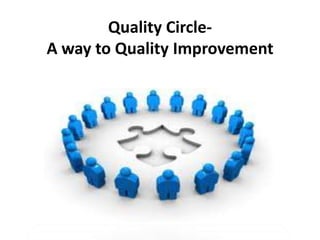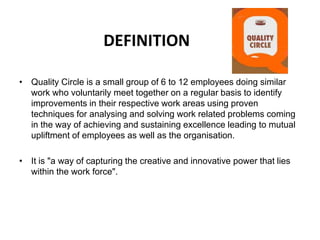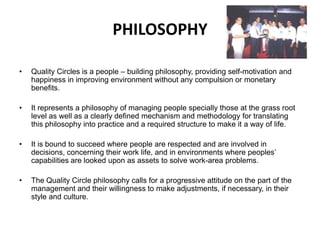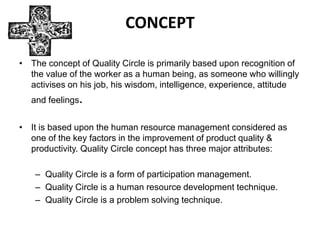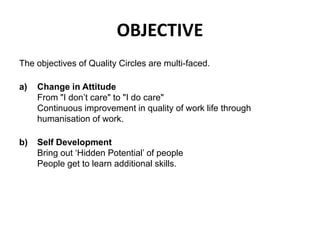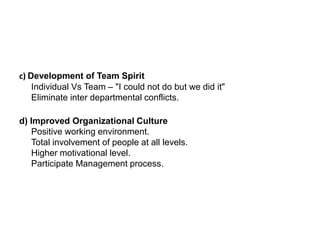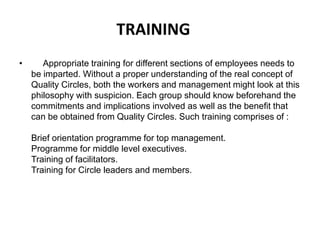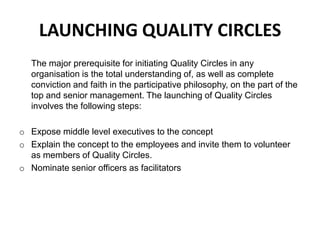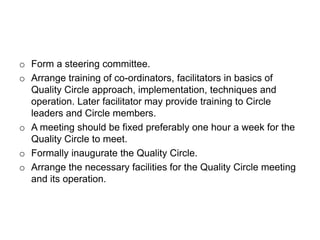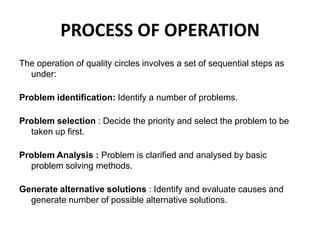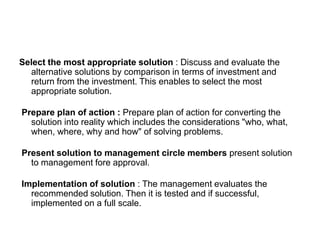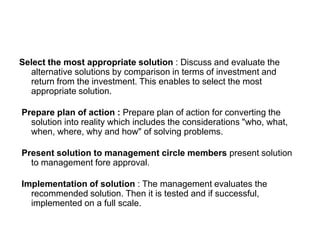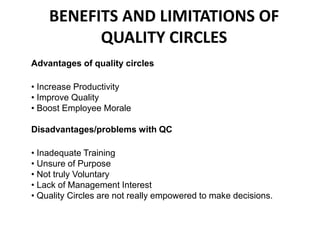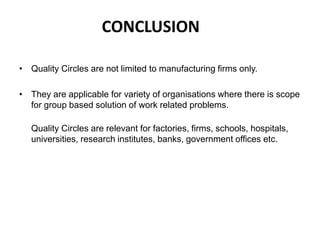Qualitycircle tqm
- 1. Quality Circle- A way to Quality Improvement
- 2. INTRODUCTION âĒ Quality circles were originally associated with Japanese management and manufacturing techniques. The introduction of quality circles in Japan in the postwar years was inspired by the lectures of W. Edwards Deming (1900- 1993), a statistician for the U.S. government. âĒ Quality Circle is one of the employee participation methods. It implies the development of skills, capabilities, confidence and creativity of the people through cumulative process of education, training, work experience and participation. âĒ It also implies the creation of facilitative conditions and environment of work, which creates and sustains their motivation and commitment towards work excellence. âĒ Quality Circles have emerged as a mechanism to develop and utilize the tremendous potential of people for improvement in product quality and productivity.
- 3. DEFINITION âĒ Quality Circle is a small group of 6 to 12 employees doing similar work who voluntarily meet together on a regular basis to identify improvements in their respective work areas using proven techniques for analysing and solving work related problems coming in the way of achieving and sustaining excellence leading to mutual upliftment of employees as well as the organisation. âĒ It is "a way of capturing the creative and innovative power that lies within the work force".
- 4. PHILOSOPHY âĒ Quality Circles is a people â building philosophy, providing self-motivation and happiness in improving environment without any compulsion or monetary benefits. âĒ It represents a philosophy of managing people specially those at the grass root level as well as a clearly defined mechanism and methodology for translating this philosophy into practice and a required structure to make it a way of life. âĒ It is bound to succeed where people are respected and are involved in decisions, concerning their work life, and in environments where peoplesâ capabilities are looked upon as assets to solve work-area problems. âĒ The Quality Circle philosophy calls for a progressive attitude on the part of the management and their willingness to make adjustments, if necessary, in their style and culture.
- 5. CONCEPT âĒ The concept of Quality Circle is primarily based upon recognition of the value of the worker as a human being, as someone who willingly activises on his job, his wisdom, intelligence, experience, attitude and feelings. âĒ It is based upon the human resource management considered as one of the key factors in the improvement of product quality & productivity. Quality Circle concept has three major attributes: â Quality Circle is a form of participation management. â Quality Circle is a human resource development technique. â Quality Circle is a problem solving technique.
- 6. OBJECTIVE The objectives of Quality Circles are multi-faced. a) Change in Attitude From "I donât care" to "I do care" Continuous improvement in quality of work life through humanisation of work. b) Self Development Bring out âHidden Potentialâ of people People get to learn additional skills.
- 7. c) Development of Team Spirit Individual Vs Team â "I could not do but we did it" Eliminate inter departmental conflicts. d) Improved Organizational Culture Positive working environment. Total involvement of people at all levels. Higher motivational level. Participate Management process.
- 8. TRAINING âĒ Appropriate training for different sections of employees needs to be imparted. Without a proper understanding of the real concept of Quality Circles, both the workers and management might look at this philosophy with suspicion. Each group should know beforehand the commitments and implications involved as well as the benefit that can be obtained from Quality Circles. Such training comprises of : Brief orientation programme for top management. Programme for middle level executives. Training of facilitators. Training for Circle leaders and members.
- 9. LAUNCHING QUALITY CIRCLES The major prerequisite for initiating Quality Circles in any organisation is the total understanding of, as well as complete conviction and faith in the participative philosophy, on the part of the top and senior management. The launching of Quality Circles involves the following steps: o Expose middle level executives to the concept o Explain the concept to the employees and invite them to volunteer as members of Quality Circles. o Nominate senior officers as facilitators
- 10. o Form a steering committee. o Arrange training of co-ordinators, facilitators in basics of Quality Circle approach, implementation, techniques and operation. Later facilitator may provide training to Circle leaders and Circle members. o A meeting should be fixed preferably one hour a week for the Quality Circle to meet. o Formally inaugurate the Quality Circle. o Arrange the necessary facilities for the Quality Circle meeting and its operation.
- 11. PROCESS OF OPERATION The operation of quality circles involves a set of sequential steps as under: Problem identification: Identify a number of problems. Problem selection : Decide the priority and select the problem to be taken up first. Problem Analysis : Problem is clarified and analysed by basic problem solving methods. Generate alternative solutions : Identify and evaluate causes and generate number of possible alternative solutions.
- 12. Select the most appropriate solution : Discuss and evaluate the alternative solutions by comparison in terms of investment and return from the investment. This enables to select the most appropriate solution. Prepare plan of action : Prepare plan of action for converting the solution into reality which includes the considerations "who, what, when, where, why and how" of solving problems. Present solution to management circle members present solution to management fore approval. Implementation of solution : The management evaluates the recommended solution. Then it is tested and if successful, implemented on a full scale.
- 13. Select the most appropriate solution : Discuss and evaluate the alternative solutions by comparison in terms of investment and return from the investment. This enables to select the most appropriate solution. Prepare plan of action : Prepare plan of action for converting the solution into reality which includes the considerations "who, what, when, where, why and how" of solving problems. Present solution to management circle members present solution to management fore approval. Implementation of solution : The management evaluates the recommended solution. Then it is tested and if successful, implemented on a full scale.
- 14. BENEFITS AND LIMITATIONS OF QUALITY CIRCLES Advantages of quality circles âĒ Increase Productivity âĒ Improve Quality âĒ Boost Employee Morale Disadvantages/problems with QC âĒ Inadequate Training âĒ Unsure of Purpose âĒ Not truly Voluntary âĒ Lack of Management Interest âĒ Quality Circles are not really empowered to make decisions.
- 15. CONCLUSION âĒ Quality Circles are not limited to manufacturing firms only. âĒ They are applicable for variety of organisations where there is scope for group based solution of work related problems. Quality Circles are relevant for factories, firms, schools, hospitals, universities, research institutes, banks, government offices etc.
- 16. Thank You!!
